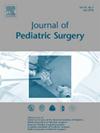Functional Outcomes of Anterior Sagittal Anorectoplasty Repair for Rectovestibular Fistula: An Integrated Clinical and MRI-based Assessment: Initial Findings
IF 2.4
2区 医学
Q1 PEDIATRICS
引用次数: 0
Abstract
Background/Purpose
This study aimed to assess the functional outcomes of anterior sagittal anorectoplasty for rectovestibular fistula using an integrated Rintala clinical continence score and MRI-based assessment.
Methods
Between October 2022 and April 2024, female patients with rectovestibular fistula who underwent anterior sagittal anorectoplasty were investigated. The patients were at least 4 years old, and cases with spinal cord anomalies or sacral dysplasia were excluded. MRI was performed and linked to the Rintala clinical continence score. The MRI parameters assessed were anorectal angle, striated muscle surrounding the neorectum, centrality of the neorectum, pubococcygeal (PC) distance, and pelvic hiatal distance.
Results
Twelve patients (mean age 68.6 months, range 54–108) were enrolled in this study. The findings revealed that the anorectal angle was strongly correlated with the total Rintala score (Spearman rank = −0.831, p < 0.001), social problems (Spearman rank = −0.879, p < 0.001), and accidents (Spearman rank = −0.790, p = 0.002). Additionally, the hiatal/pubococcygeal ratio was correlated with the total Rintala score (Spearman rank = −0.627, p = 0.029), the ability to hold back defecation (Spearman rank = −0.725, p = 0.008), soiling (Spearman rank = −0.733, p = 0.007), and accidents (Spearman rank = −0.778, p = 0.002). Furthermore, deficient striated muscle significantly correlated with the total Rintala score (Spearman rank = −0.652, p = 0.022) and accidents (Spearman rank = −0.827, p < 0.001). Non-centralized neorectum correlated with the urge to defecate (Spearman rank = −0.674, p = 0.016) and soiling (Spearman rank = −0.548, p = 0.065). Additionally, the presence of fat tissue between the anorectum and the muscle was correlated with constipation (Spearman rank = −0.529, p = 0.077).
Conclusions
The anatomical findings following anterior sagittal anorectoplasty for repairing the rectovestibular fistula are crucial in determining the functional outcome. To enhance functional outcomes, meticulous surgical techniques are essential to achieve a more acute anorectal angle, maintain the integrity of the striated muscle sphincter, align the neorectum centrally, and ensure an appropriate size of the pelvic hiatus.
Level of Evidence
Level IV.
求助全文
约1分钟内获得全文
求助全文
来源期刊
CiteScore
1.10
自引率
12.50%
发文量
569
审稿时长
38 days
期刊介绍:
The journal presents original contributions as well as a complete international abstracts section and other special departments to provide the most current source of information and references in pediatric surgery. The journal is based on the need to improve the surgical care of infants and children, not only through advances in physiology, pathology and surgical techniques, but also by attention to the unique emotional and physical needs of the young patient.

 求助内容:
求助内容: 应助结果提醒方式:
应助结果提醒方式:


